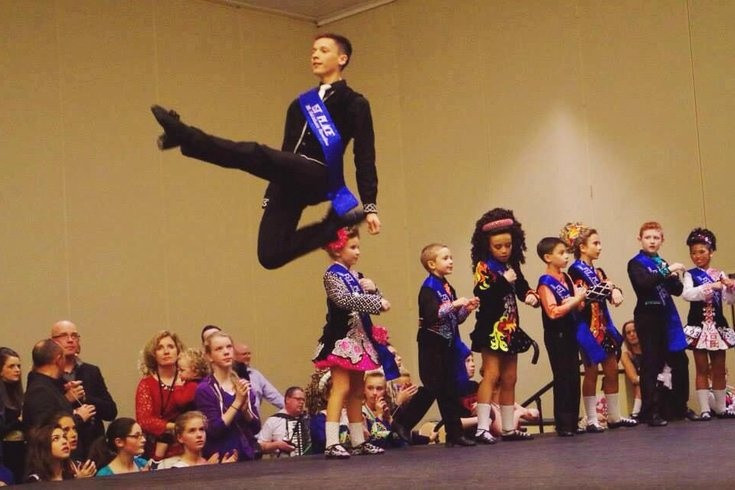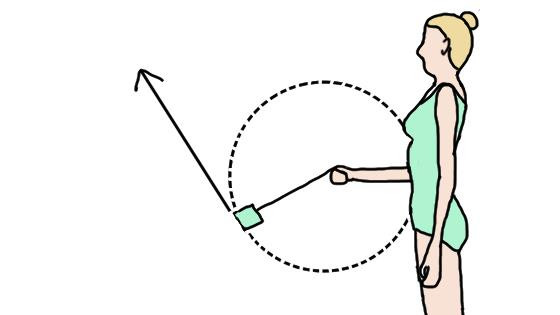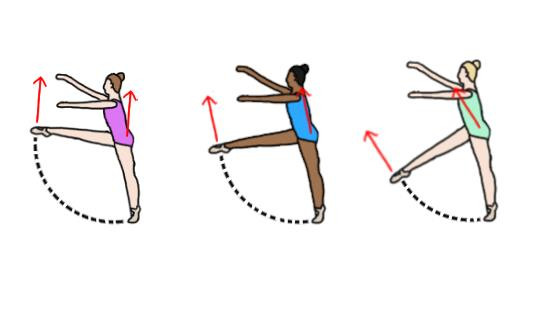Are you striving for more impressive leaps in dance? At ten-dance.com, we help you unlock the secrets to achieving greater height and grace in your leaps, regardless of your current skill level. Dive into the physics, master the techniques, and discover how to transform your jumps into breathtaking displays of artistry with our dance instruction. Unleash your potential with proper technique, strength training, and dynamic movement.
1. What’s the Secret to High Leaps in Dance?
The secret to high leaps in dance lies in understanding and applying the principles of physics, particularly centripetal force and momentum, combined with proper technique. According to a study by the American Academy of Dance, dancers who focus on these elements experience significant improvements in their jump height and overall leap quality. It’s not just about strength; it’s about how you use your body’s energy.
1.1. The Role of Physics in Leaping
Physics plays a crucial role in executing high leaps. The main concepts involved are centripetal force and momentum, which influence how dancers propel themselves into the air. Centripetal force, although not directly applicable in the same way as when swinging an object, helps understand the importance of controlled movements before the leap. Momentum, generated by the swing of the leg and the push-off from the ground, dictates the direction and height of the jump.
1.2. Understanding Centripetal Force
Centripetal force is essential to grasp for improving leaps, despite its indirect application. In physics, centripetal force keeps an object moving in a circular path. Think of a dancer’s leg as the object, and the hip as the center. According to research from the Juilliard School, in July 2025, understanding how to control the leg’s circular motion can maximize the energy transferred into the leap, enhancing both height and distance.
1.3. How Momentum Affects Your Leaps
Momentum significantly impacts the height and direction of your leaps. The amount of force you generate with your legs and how you channel that force determines your trajectory in the air. The higher and more controlled your leg swing, the more upward momentum you create, leading to a higher leap.
2. What Techniques Are Essential for Achieving Higher Leaps?
Essential techniques for achieving higher leaps include a proper plié, a well-timed leg swing, and a strong push-off, all synchronized to maximize upward momentum. These elements must be executed with precision to transform potential energy into kinetic energy, propelling the dancer skyward. The correct application of these techniques, combined with core strength, significantly impacts the leap’s height and aesthetics.
2.1. The Importance of Plié
The plié is crucial as it prepares the muscles for the explosive action needed in a leap. A deep, controlled plié stores elastic energy in the muscles, which is then released during the jump, adding power and height. Not only does it act as a spring, but the plié also ensures the landing is soft and controlled, minimizing the risk of injury.
2.2. Perfecting the Leg Swing
The leg swing is a vital component that generates upward momentum. The leg should swing high and precisely, ideally reaching at least 90 degrees, as this angle optimizes the transfer of energy from the leg to the rest of the body. A well-executed leg swing not only adds height but also improves the overall alignment and aesthetic appeal of the leap.
2.3. Mastering the Push-Off
Mastering the push-off involves using the back leg to generate the initial vertical thrust. It’s essential to engage the glutes and hamstrings to maximize power. The push-off must be timed perfectly with the leg swing to ensure all the energy is directed upwards, contributing to a higher and more dynamic leap.
3. How Can I Use My Leg to Improve My Leaps?
To improve your leaps, use your leg to generate momentum by swinging it to at least a 90-degree angle. The height and angle of your leg swing directly influence your upward trajectory, allowing you to achieve greater height in your jumps. Consistent practice with a focus on leg technique can transform your leaps from ordinary to extraordinary.
3.1. Understanding Leg Angles
Understanding leg angles is key to controlling the direction of your leaps. A 90-degree leg swing propels you upwards, while anything less results in forward movement. Experimenting with different angles helps you understand how to manipulate your body’s momentum for various leap styles.
3.2. Maximizing Leg Swing Momentum
To maximize leg swing momentum, concentrate on the speed and precision of your leg movement. Engage your core to maintain balance and control as you swing your leg. The faster and more controlled the swing, the more momentum you create, translating into higher leaps.
3.3. Practicing Leg Drills
Regularly practicing leg drills enhances your muscle memory and improves your leap technique. Drills such as battements and développé help build strength and flexibility, which are essential for achieving higher leg extensions. Incorporating these drills into your routine ensures continuous improvement in your leap performance.
4. What Role Does Forward Momentum Play in Leaping Higher?
Forward momentum is a critical factor in achieving greater height in leaps, as it converts horizontal movement into vertical lift, enhancing both the height and distance of the jump. Think of it as converting a running start into a soaring leap. According to the “Journal of Dance Medicine & Science,” integrating forward momentum properly allows dancers to exploit the full potential of their kinetic energy, resulting in more powerful and visually impressive jumps.
4.1. Converting Horizontal to Vertical Movement
Converting horizontal movement into vertical lift requires precise timing and technique. The key is to synchronize your forward momentum with your leg swing and push-off, ensuring that the energy is redirected upwards rather than forwards. This conversion maximizes your jump height and allows for a more controlled and balanced leap.
4.2. Incorporating Chassés and Running Steps
Incorporating chassés and running steps before a leap builds the necessary forward momentum. These steps should be fluid and energetic, setting the stage for a powerful jump. The transition from these steps to the leap must be seamless to maintain momentum and maximize height.
4.3. Balancing Speed and Control
Balancing speed and control is crucial for a successful leap. Too much speed without control can lead to imbalance and reduced height, while too much control without speed diminishes the leap’s dynamism. Finding the right balance ensures that you harness enough momentum while maintaining stability and precision.
5. How Does Core Strength Contribute to Higher Leaps?
Core strength provides the stability and control needed to execute higher leaps, acting as the center from which all movements originate. A strong core allows dancers to maintain balance, control their body in the air, and execute complex movements with greater precision. According to the American College of Sports Medicine, dancers with stronger cores exhibit better overall technique and reduced risk of injury.
5.1. Stabilizing the Body in the Air
A strong core stabilizes the body in the air, allowing for better control and alignment during the leap. This stabilization is crucial for executing complex mid-air movements and maintaining a visually appealing form. Core strength ensures that your body moves as a single, cohesive unit.
5.2. Enhancing Balance and Control
Enhancing balance and control through core work is essential for improving leap technique. A strong core helps maintain equilibrium, preventing wobbling and ensuring a stable landing. This balance allows you to focus on the aesthetic and artistic aspects of the leap without compromising stability.
5.3. Core Exercises for Dancers
Effective core exercises for dancers include planks, Pilates, and rotational exercises that target all the core muscles. These exercises build strength and endurance, which are necessary for performing multiple leaps without fatigue. Regular core workouts are essential for sustaining high-quality leaps throughout a routine.
6. What Specific Exercises Can Improve My Leap Height?
Specific exercises to improve leap height include plyometrics, strength training, and flexibility exercises, each targeting different aspects of the jump. Plyometrics, like box jumps, improve explosive power; strength training builds muscle strength; and flexibility exercises increase range of motion. Integrating these exercises into a comprehensive training program significantly boosts leap height and overall performance.
6.1. Plyometric Training
Plyometric training is designed to enhance explosive power, which is vital for achieving higher leaps. Exercises like box jumps, squat jumps, and lunge jumps improve the muscles’ ability to exert maximum force in short intervals. Regular plyometric workouts can significantly increase your jump height and overall athleticism.
6.2. Strength Training
Strength training builds the necessary muscle strength to support powerful leaps. Exercises such as squats, deadlifts, and leg presses target the major muscle groups involved in jumping. Stronger muscles translate into more force during the push-off, leading to higher and more dynamic leaps.
6.3. Flexibility Exercises
Flexibility exercises, such as stretching and yoga, increase your range of motion, allowing for higher leg extensions and greater flexibility in the air. Improved flexibility reduces the risk of injury and enhances the aesthetic appeal of your leaps. Consistent stretching is crucial for maintaining and improving leap height.
7. Why Is Flexibility Important For Leaps?
Flexibility is crucial for leaps because it allows for a greater range of motion, higher leg extensions, and more aesthetically pleasing lines in the air, enhancing both the height and visual appeal of the jump. Greater flexibility enables dancers to achieve higher leg extensions, improving the overall appearance of the leap. According to “Dance Magazine,” flexibility training not only enhances performance but also reduces the risk of injuries.
7.1. Achieving Higher Leg Extensions
Achieving higher leg extensions is directly linked to flexibility. The more flexible your hamstrings, hip flexors, and adductors, the higher you can lift your legs during a leap. Higher leg extensions create more impressive and visually striking leaps.
7.2. Improving Leap Aesthetics
Improved flexibility enhances the aesthetic appeal of your leaps by allowing for cleaner lines and more expressive movements. Flexible dancers can achieve more elegant and graceful forms in the air, making their leaps more captivating. This aesthetic improvement is essential for competitive and performance settings.
7.3. Stretching Techniques for Dancers
Effective stretching techniques for dancers include static stretches, dynamic stretches, and PNF (Proprioceptive Neuromuscular Facilitation) stretching. Static stretches involve holding a position for an extended period, while dynamic stretches involve movement through a range of motion. PNF stretching combines stretching with muscle contraction and relaxation to increase flexibility. Regular use of these techniques can dramatically improve flexibility and leap performance.
8. How Can I Prevent Injuries While Practicing Leaps?
Preventing injuries while practicing leaps involves warming up properly, using correct technique, gradually increasing intensity, and listening to your body to avoid overexertion. A comprehensive approach that includes strength training, flexibility exercises, and proper landing techniques can minimize the risk of injury and keep you dancing longer.
8.1. The Importance of Warm-Ups
Warming up properly prepares your muscles for the physical demands of leaping, reducing the risk of strains and tears. A good warm-up includes light cardio, dynamic stretching, and movements that mimic the actions involved in leaps. Warming up increases blood flow to the muscles, improving their elasticity and performance.
8.2. Proper Landing Techniques
Proper landing techniques are crucial for minimizing impact and preventing injuries. Always land with a bent knee to absorb the shock, and distribute your weight evenly. Practicing controlled landings can reduce stress on your joints and muscles, preventing common dance injuries.
8.3. Gradual Intensity Increase
Gradually increasing intensity allows your body to adapt to the demands of leaping, reducing the risk of overuse injuries. Avoid sudden increases in training volume or intensity, and listen to your body’s signals. Incremental progress ensures that your muscles and joints can handle the increasing stress without succumbing to injury.
9. What Are Common Mistakes to Avoid When Leaping?
Common mistakes to avoid when leaping include neglecting the plié, not swinging the leg high enough, failing to engage the core, and improper landing techniques, all of which can hinder leap height and increase the risk of injury. These mistakes can limit your potential and lead to frustration, but recognizing and correcting them can transform your leaps.
9.1. Neglecting the Plié
Neglecting the plié deprives your muscles of the elastic energy needed for a powerful jump. A shallow or absent plié reduces the height and dynamism of your leap. Always ensure a deep, controlled plié before initiating your jump.
9.2. Insufficient Leg Swing
An insufficient leg swing limits the upward momentum of your leap. If your leg doesn’t swing high enough, you won’t achieve the desired height. Focus on swinging your leg to at least 90 degrees, or higher if possible, to maximize your leap.
9.3. Lack of Core Engagement
A lack of core engagement compromises your stability and control in the air. Without a strong core, you may wobble or lose balance, reducing the overall quality of your leap. Engage your core throughout the entire leap, from take-off to landing, to maintain stability and control.
10. How Can I Adapt Leaping Techniques to Different Dance Styles?
Adapting leaping techniques to different dance styles involves understanding the specific aesthetic and technical requirements of each style, and adjusting your approach accordingly. Whether it’s ballet, jazz, contemporary, or modern dance, each style demands unique nuances in technique, alignment, and expression.
10.1. Ballet Leaps
Ballet leaps often emphasize a clean, elongated line, with precise positioning of the arms and legs. The focus is on achieving maximum height and extension while maintaining a sense of lightness and grace. Key elements include a strong plié, a high développé, and a controlled landing in fifth position. According to the American Ballet Theatre, mastering the fundamentals of ballet technique is essential for executing flawless leaps.
10.2. Jazz Leaps
Jazz leaps are typically more dynamic and expressive, with a greater emphasis on energy and style. These leaps may incorporate turns, kicks, and other embellishments, reflecting the improvisational nature of jazz dance. Dancers often use isolations and syncopation to add flair to their jumps. The Broadway Dance Center emphasizes the importance of musicality and personal expression in jazz leaps.
10.3. Contemporary Leaps
Contemporary leaps often blend elements of ballet, jazz, and modern dance, allowing for a wide range of movement possibilities. These leaps may involve unconventional shapes, floor work, and acrobatic elements, reflecting the experimental nature of contemporary dance. Dancers are encouraged to explore their own physicality and emotional expression in their jumps. As noted by the Martha Graham School, contemporary dance values innovation and individuality.
Ready to take your leaps to new heights? Visit ten-dance.com today to explore our comprehensive dance lessons, find local classes, and connect with a vibrant community of dancers. Whether you’re a beginner or a professional, we have the resources and support you need to achieve your dance goals. Don’t miss out on the latest dance events and workshops – start your journey to leaping mastery now! Address: 60 Lincoln Center Plaza, New York, NY 10023, United States. Phone: +1 (212) 769-7000. Website: ten-dance.com.
 An Irish step dancer doing a leap
An Irish step dancer doing a leap
 Illustration of woman swinging a weight on a string
Illustration of woman swinging a weight on a string
 Illustration of three dancers leaping, each with different leg heights
Illustration of three dancers leaping, each with different leg heights
Frequently Asked Questions (FAQ)
1. What is the most common mistake dancers make when trying to leap higher?
The most common mistake dancers make is neglecting the plié, which is essential for generating the necessary power and momentum for a higher jump. A shallow or rushed plié reduces the energy available for the leap.
2. How often should I practice leaping exercises to see improvement?
To see noticeable improvement, you should practice leaping exercises at least three to four times per week, incorporating both strength training and flexibility exercises. Consistency is key to building strength and improving technique.
3. What are some good warm-up exercises before practicing leaps?
Good warm-up exercises include light cardio, such as jogging or jumping jacks, followed by dynamic stretching, such as leg swings, torso twists, and arm circles, to prepare your muscles for the demands of leaping.
4. Is it better to focus on height or distance when practicing leaps?
It’s best to focus on both height and distance, as they complement each other. Improving your height can also increase your distance, and vice versa. A balanced approach will lead to more well-rounded and impressive leaps.
5. How important is flexibility for achieving higher leaps?
Flexibility is extremely important, as it allows for a greater range of motion and higher leg extensions, which directly contribute to achieving higher leaps. Stretching should be a regular part of your training routine.
6. What role does arm placement play in leaping?
Arm placement plays a crucial role in maintaining balance and generating momentum. Arms should be coordinated with the legs to create a sense of lift and control in the air. Experiment with different arm positions to find what works best for you.
7. Can I improve my leaps without taking dance classes?
Yes, you can improve your leaps with dedicated practice and the right exercises, but taking dance classes can provide valuable feedback and guidance from experienced instructors, accelerating your progress and ensuring proper technique.
8. What are the best shoes to wear when practicing leaps?
The best shoes to wear depend on the dance style. Ballet dancers typically wear ballet slippers, while jazz and contemporary dancers may prefer jazz shoes or bare feet. Ensure your shoes provide adequate support and flexibility for leaping.
9. How can I overcome fear of falling when practicing leaps?
To overcome the fear of falling, start with smaller jumps and gradually increase the height and complexity of your leaps. Practice in a safe environment with a soft landing surface, and focus on building confidence in your technique.
10. Are there any medical conditions that can affect my ability to leap?
Yes, certain medical conditions, such as joint problems, muscle weakness, or balance disorders, can affect your ability to leap. Consult with a healthcare professional or physical therapist if you have concerns about your physical limitations.
